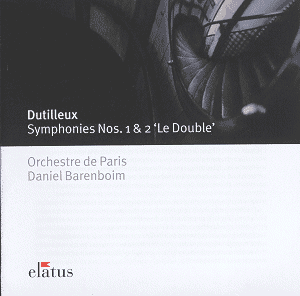Dutilleux has not been a prolific producer. Far
from it. There have been less than a dozen works to date.
The First Symphony was premiered by the
French National Orchestra conducted by Roger Désormière
on 7 June 1951. It has an instinctive symmetry with a fast and
belligerent scherzo (II) typical of the outburst movements
that appear in the Panufnik symphonies (e.g. Elegiaca).
This is flanked by a reflective Passacaille and Intermezzo
written in a style that seems to develop from the more elysian
passages in The Rite of Spring. The apocalyptic brass writing
in the fourth movement is surely influenced by the highly original
William Schumann in his violin concerto and third symphony. Finally
the symphony sings itself, almost sweetly and certainly warmly,
back into the shadows from which it emerged. That bathing in comfort
can also be heard in the final pages of the Second Symphony.
The Second Symphony was completed on the
brink of the 'sixties - a decade of kicking over the traces of
conventions and establishing new ones. It was premiered by the
Boston Symphony with Charles Munch on 11 December 1959 then again
in Besançon on 7 September 1960. The more intimate string
and solo wind writing is again linked to the example of Stravinsky
in The Rite with added flavour from the harpsichord ...
and this idea appears with variant treatment in each of the three
movements lending symphonic cohesion. The orchestra is treated
as two concertante entities (hence Double) with the two
wrestling, competing, holding up distorting mirrors to each other,
interacting. The sense of separation is probably more apparent
if you are following with a score. Left to your own aural devices
you would not pick this up. The finale has a joyous life-affirming
dimension which occasionally reminded me of Walton's caustic writing
for brass in the Second Symphony. Its sharp rhythmic life is accentuated
by the harpsichord and solo voices from the orchestra; Dutilleux
scores seethe with detailing and incident. The ending glances
towards the misty aubade images of Ravel's Rapsodie Espagnole.
The recordings have plenty of clarity and atmosphere
with details emerging pleasingly and demonstrative writing rendered
with impact. One minor point: I noticed a burbling noise at the
end of track 7 after the symphony had ended. A minor distraction.
I am not familiar with alternative recordings
but none with this coupling will be at Elatus's bargain price.
In their own right the recordings have a tranced commitment that
makes it unlikely they will be bettered elsewhere.
Rob Barnett
